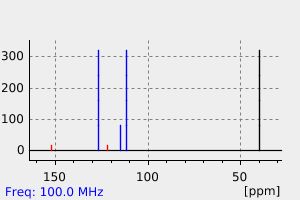1-(difluormethyl)-4-(dimethylamino)benzol | 705-39-5
中文名称
——
中文别名
——
英文名称
1-(difluormethyl)-4-(dimethylamino)benzol
英文别名
4-(difluoromethyl)-N,N-dimethylaniline;N,N-dimethyl-4-(difluoromethyl)aniline;p-Dimethylaminobenzyliden-fluorid
CAS
705-39-5
化学式
C9H11F2N
mdl
——
分子量
171.19
InChiKey
RHWZABSJSJYUPX-UHFFFAOYSA-N
BEILSTEIN
——
EINECS
——
-
物化性质
-
计算性质
-
ADMET
-
安全信息
-
SDS
-
制备方法与用途
-
上下游信息
-
文献信息
-
表征谱图
-
同类化合物
-
相关功能分类
-
相关结构分类
计算性质
-
辛醇/水分配系数(LogP):3.1
-
重原子数:12
-
可旋转键数:2
-
环数:1.0
-
sp3杂化的碳原子比例:0.33
-
拓扑面积:3.2
-
氢给体数:0
-
氢受体数:3
上下游信息
-
上游原料
中文名称 英文名称 CAS号 化学式 分子量 N,N-二甲基-4-(三氟甲基)苯胺 N,N-dimethyl-4-(trifluoromethyl)aniline 329-17-9 C9H10F3N 189.18 对二甲氨基苯甲醛 4-dimethylamino-benzaldehyde 100-10-7 C9H11NO 149.192
反应信息
-
作为产物:参考文献:名称:Haas, Alois; Spitzer, Martin; Lieb, Max, Chemische Berichte, 1988, vol. 121, p. 1329 - 1340摘要:DOI:
文献信息
-
METHOD AND REAGENT FOR DEOXYFLUORINATION申请人:South Dakota Board of Regents公开号:US20210155561A1公开(公告)日:2021-05-27A safe, simple, and selective method and reagent for deoxyfluorination is disclosed. With the method and reagent disclosed herein, organic compounds such as carboxylic acids, carboxylates, carboxylic acid anhydrides, aldehydes, and alcohols can be fluorinated by using the most common nucleophilic fluorinating reagents and electron deficient fluoroarenes as mediators under mild conditions, giving corresponding fluoroorganic compounds in excellent yield with a wide range of functional group compatibility and easy product purification. For example, directly utilizing KF for deoxyfluorination of carboxylic acids provides the most economical and the safest pathway to access acyl fluorides, key intermediates for syntheses of peptide, amide, ester, and dry fluoride salts.
-
Sandmeyer Difluoromethylation of (Hetero-)Arenediazonium Salts作者:Christian Matheis、Kévin Jouvin、Lukas J. GoossenDOI:10.1021/ol5030037日期:2014.11.21straightforward conversion of (hetero-)arenediazonium salts into the corresponding difluoromethyl (hetero-)arenes under mild conditions. The actual difluoromethylating reagent, a difluoromethyl–copper complex, is formed in situ from copper thiocyanate and TMS–CF2H. The diazonium salts are either preformed or generated in situ from broadly available aromatic amines.
-
[Ph <sub>4</sub> P] <sup>+</sup> [Cu(CF <sub>2</sub> H) <sub>2</sub> ] <sup>−</sup> : A Powerful Difluoromethylating Reagent Inspired by Mechanistic Investigation作者:Haiwei Zhao、Xuebing B. Leng、Wei Zhang、Qilong ShenDOI:10.1002/anie.202210151日期:2022.10.17A powerful difluoromethylating reagent [Ph4P]+[Cu(CF2H)2]− that was able to difluoromethylate a variety of aryl and alkyl electrophiles was developed. In the presence of an oxidant, complex 2 also reacted with various lithium nbutyl arylboronic acid pinacol esters, alkyne and heteroarene. Moreover, complex 2 could transmetalate the difluoromethyl reagent to other metals such as [Ph4P]+[Cu(Cl2)]− and
-
Electronically Ambivalent Hydrodefluorination of Aryl‐CF <sub>3</sub> groups enabled by Electrochemical Deep‐Reduction on a Ni Cathode作者:John R. Box、Mickaël E. Avanthay、Darren L. Poole、Alastair J. J. LennoxDOI:10.1002/anie.202218195日期:2023.3.13We report a general procedure for the direct mono- and di-hydrodefluorination of ArCF3 compounds. Exploiting the tunability of electrochemistry and the selectivity enabled by a Ni cathode, the deep reduction garners high selectivity with good to excellent yields up to gram scale. The late-stage peripheral editing of CF3 feedstocks to construct fluoromethyl moieties will aid the rapid diversification
-
Pasternak,V.I. et al., Journal of Organic Chemistry USSR (English Translation), 1978, vol. 14, p. 2298 - 2301作者:Pasternak,V.I. et al.DOI:——日期:——
表征谱图
-
氢谱1HNMR
-
质谱MS
-
碳谱13CNMR
-
红外IR
-
拉曼Raman
-
峰位数据
-
峰位匹配
-
表征信息
同类化合物
(乙腈)二氯镍(II)
(R)-(-)-α-甲基组胺二氢溴化物
(N-(2-甲基丙-2-烯-1-基)乙烷-1,2-二胺)
(4-(苄氧基)-2-(哌啶-1-基)吡啶咪丁-5-基)硼酸
(11-巯基十一烷基)-,,-三甲基溴化铵
鼠立死
鹿花菌素
鲸蜡醇硫酸酯DEA盐
鲸蜡硬脂基二甲基氯化铵
鲸蜡基胺氢氟酸盐
鲸蜡基二甲胺盐酸盐
高苯丙氨醇
高箱鲀毒素
高氯酸5-(二甲氨基)-1-({(E)-[4-(二甲氨基)苯基]甲亚基}氨基)-2-甲基吡啶正离子
高氯酸2-氯-1-({(E)-[4-(二甲氨基)苯基]甲亚基}氨基)-6-甲基吡啶正离子
高氯酸2-(丙烯酰基氧基)-N,N,N-三甲基乙铵
马诺地尔
马来酸氢十八烷酯
马来酸噻吗洛尔EP杂质C
马来酸噻吗洛尔
马来酸倍他司汀
顺式环己烷-1,3-二胺盐酸盐
顺式氯化锆二乙腈
顺式吡咯烷-3,4-二醇盐酸盐
顺式双(3-甲氧基丙腈)二氯铂(II)
顺式3,4-二氟吡咯烷盐酸盐
顺式1-甲基环丙烷1,2-二腈
顺式-二氯-反式-二乙酸-氨-环己胺合铂
顺式-二抗坏血酸(外消旋-1,2-二氨基环己烷)铂(II)水合物
顺式-N,2-二甲基环己胺
顺式-4-甲氧基-环己胺盐酸盐
顺式-4-环己烯-1.2-二胺
顺式-4-氨基-2,2,2-三氟乙酸环己酯
顺式-3-氨基环丁烷甲腈盐酸盐
顺式-2-羟基甲基-1-甲基-1-环己胺
顺式-2-甲基环己胺
顺式-2-(苯基氨基)环己醇
顺式-2-(苯基氨基)环己醇
顺式-2-(氨基甲基)-1-苯基环丙烷羧酸盐酸盐
顺式-1,3-二氨基环戊烷
顺式-1,2-环戊烷二胺二盐酸盐
顺式-1,2-环戊烷二胺
顺式-1,2-环丁腈
顺式-1,2-双氨甲基环己烷
顺式--N,N'-二甲基-1,2-环己二胺
顺式-(R,S)-1,2-二氨基环己烷铂硫酸盐
顺式-(2-氨基-环戊基)-甲醇
顺-2-戊烯腈
顺-1,3-环己烷二胺
顺-1,3-双(氨甲基)环己烷







